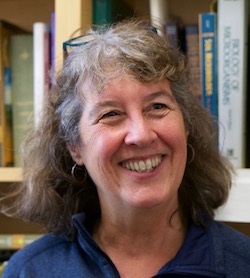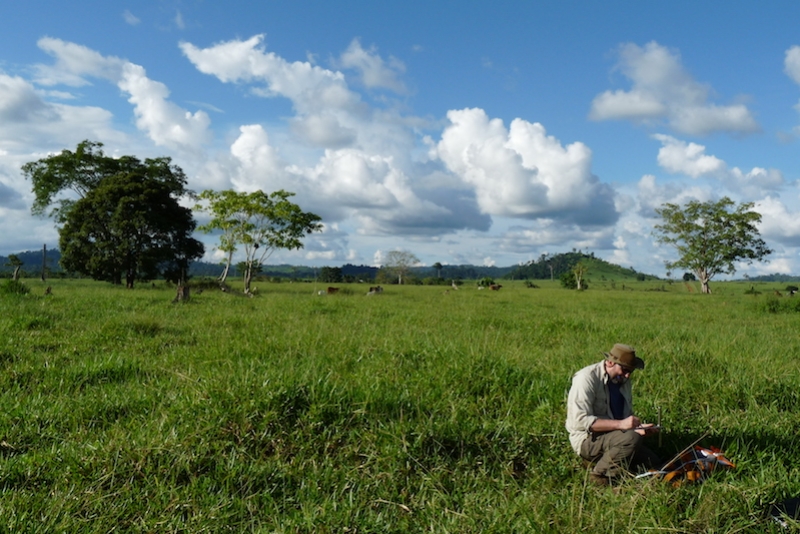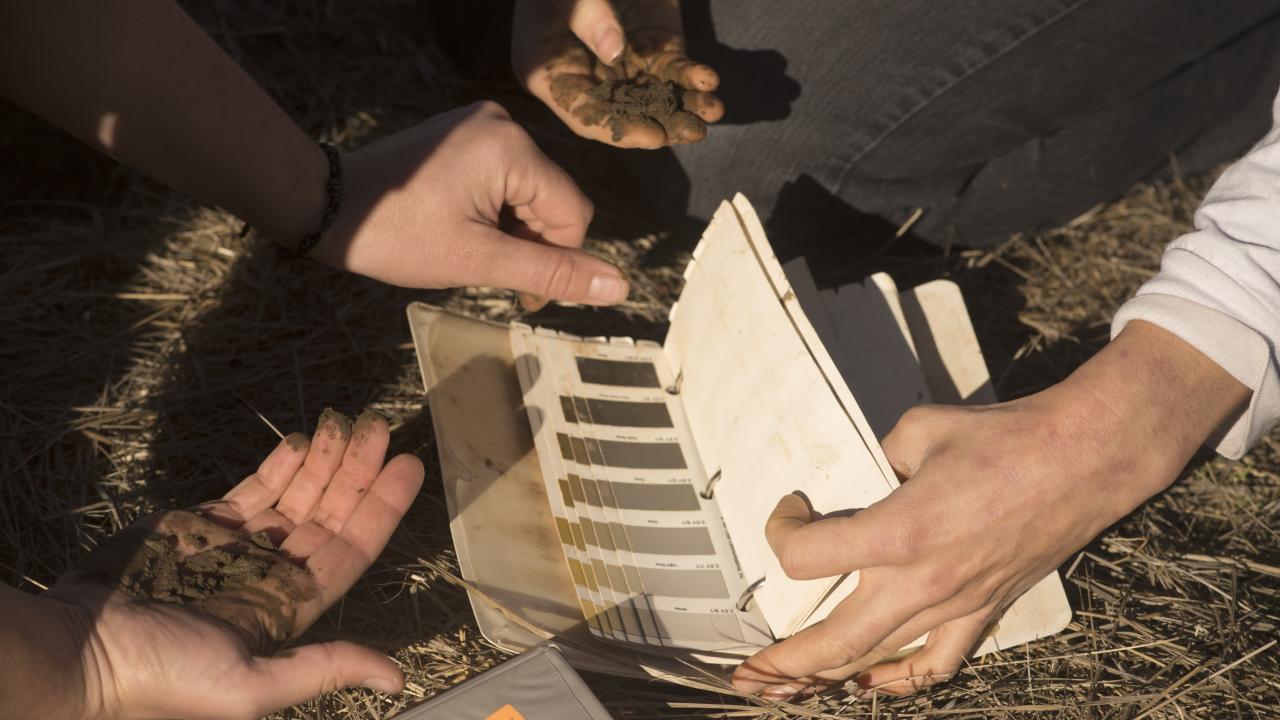Kate Scow, a professor of soil science and soil microbial ecology at UC Davis, keeps plastic bags filled with soil on her desk.
We are meeting in her office in Plant and the Environmental Sciences Building on campus, not out at Russell Ranch, where she’s the director of the university’s unique 300-acre research facility studying the long-term impacts of management practices and climate on agricultural sustainability. California is finally rainy again. “Our soils are sopping wet and it’s kind of hard to move around there right now,” says Scow.
One of the bags is filled with crumbly light-brown earth that holds together in small clumps. It’s from an organically-managed tomato field. Another bag holds an almost solid, gray block of dirt, like a brick of cement.
“It’s because it was tilled when it was wet. The structure has completely broken down.” She grabs the bag and holds it up. “But you might be surprised that even this boulder has some microorganisms in it. They are everywhere.”

Microbial ecology is one of Scow’s primary research areas. What she is trying to understand is how we can refocus agricultural practices “below-ground” and enhance the activity of beneficial microorganisms. Just a few of her recent research projects include looking at the sensitivity of bacteria and fungi to tillage and cover crops, and the impacts of mineral fertilizer on managed and nonmanaged agricultural systems.
Even though microbes in soil are essential for life on earth, scientists readily admit they still know relatively little about them. What they do know is that they are very, very plentiful and very, very diverse.
“A gram of soil — about a quarter of a teaspoon — can easily contain a billion bacterial cells and several miles of fungal filaments,” says Scow.
And how many different types of organisms might be in the soil? “Soil is overwhelmingly diverse, with an estimated 10,000 to 50,000 different taxa in a teaspoon of soil. These numbers are difficult to guess and keep getting adjusted as we learn more about the soil microbiome through sequencing efforts,” says Scow, referencing genomic sequencing, which identifies organisms by their unique genetic traits.
A living ecosystem
Unlike Scow, when most of us drive by a freshly plowed agricultural field, we see dirt. We might picture the presence of a few bugs, maybe worms, but essentially, most of us see soil as an inanimate substrate into which plants grow.
Five Things You Didn't Know About the Soil Microbiome
First, it has one! Plus, did you know:
- UC Davis sent soil microbes into space
- Microbes can turn food waste into electricity
- Soil microbes could save rice crops from a major pest
- Soil microbes help capture carbon
But soil is actually a living entity, a diverse ecosystem that is one of the most complex on the planet. And it is one that is essential for human life through all the functions it provides — food production, water purification, greenhouse gas reduction, and pollution cleanup, to name a few.
“A lot of processes that are really important in soil, like the decomposition of organic material, goes into building up the soil structure — the aggregates — which are the structural units of soil,” says Scow. “These aggregates determine how well the water drains when it rains, how well it is retained when it gets dry. And the exchange of gases — like the ability to get oxygen to plant roots — is determined by the structure of the soil.”
What you see when you turn over a shovelful of healthy soil isn’t just happenstance. “Microbes are the architects that build that structure,” says Scow. And she points out that how we manage our farm soils can determine whether we help or hinder these microscopic structural engineers.
Healthy soils could help mitigate climate change
Gut microbes have received a lot of attention in recent years as researchers continue to unlock the complex relationship between human health and what is living in our intestines.
For humans there are helpful prebiotics and probiotics. It turns out that the Lactobacillus bulgaricus and Streptococcus thermophiles bacteria in yogurt are good for us. But are there similar “good bacteria” for plants and soils?
I ask Radomir Schmidt, a postdoctoral researcher in Kate Scow’s lab, that question. He laughs. “That’s the million-dollar question. We know there are a lot of soil microbes but we don’t know what a lot of them do. Not yet, anyway.”
He explains that there are helpful microbes in soil, but that researchers don’t yet know how interactions between soil microbes lead to different practical outcomes.
Microbes have incredibly diverse functions in the soil. There are nitrifying microbes that convert ammonium to nitrite, and then nitrate. There are microbes that can metabolize fertilizers and pesticides and even pollutants. But even though the properties of some soil microbes are known, there is a lot still to learn, such as how important teamwork among different organisms is in providing these services.
Carbon sequestration in soil
I had met Schmidt when he was attending a microbiome workshop on campus sponsored by the Office of Research to help UC Davis researchers network about possible interdisciplinary microbiome projects. He was there to brainstorm projects like carbon sequestration.
Soil has become a focus for looking at ways to mitigate climate change. Healthy soil is more resilient in a changing environment. It also nourishes plants, which allows the plants to remove carbon dioxide — a greenhouse gas — from the atmosphere.
And the soil itself is also a massive repository for carbon: It houses the carbon compounds of decaying plants and animals, as well as everything that lives within the soil — from microbes to worms to tree roots. And carbon is essential for soil microbes to be able to flourish.
Research has shown that changes to agricultural practices could increase the carbon stored in the soil. A 20-year study at Russell Ranch found that adding compost and cover crops to fields that grew tomatoes in rotation with corn increased the amount of soil carbon by 37 percent.
Kate Scow also took part of a long-term project led by Jeff Mitchell, a University of California Agriculture and Natural Resources Cooperative Extension specialist, that looked at the impact of conservation agriculture on the amount of carbon in the soil. The eight-year study in the San Joaquin Valley found that conservation agriculture practices could increase the amount of carbon sequestered in the soil by about 45 percent.
The state of California is so interested in the potential of soil to mitigate climate change that the California Department of Food and Agriculture allocated $7.5 million for the Healthy Soils Initiative, which has the goals of building soil carbon and reducing agricultural greenhouse gas.
Studies explore impact of agricultural techniques on microbes
Schmidt’s Ph.D. is in bacterial genetics. He began in Scow’s lab doing genetic sequencing and gradually transitioned into working more directly with agriculture. He likes getting out of the lab. “The main project I am working on right now are the effects of no-till agriculture and cover cropping on the microbiome. We know pretty well the general effects of not tilling the soil and growing cover crops but we know much less about effects on specific members of the microbial community,” says Schmidt.
For example, he points out that fungi are particularly sensitive to the physical disturbance brought about by tillage, whereas many bacteria are not as affected. For the bacteria, what mattered more was food — whether the cover crop was there are not. There may be tradeoffs with the different practices, which is one of many reasons the research is so important.
And sometimes the research results are unexpected. When Kelly Gravuer, then a Ph.D. student in Scow’s lab, did a study adding poultry compost to to three different types of soil, she was pretty sure the microbial diversity in the nutrient-poor soil would increase. It did not. It went down
“Clearly, we still have a lot to learn about how to translate knowledge gained from plant and animal experiments to the vastly different world of microbes,” says Gravuer.
Lessons from deforestation and regeneration in the Amazon
Jorge L. Mazza Rodrigues, a professor in the UC Davis Department of Land, Air and Water Resources, has been studying the impact of deforestation in the Amazon rainforest since 2008.
His first project was in Rondônia, a state close to the Bolivian border and with the distinction of having the highest rate of deforestation in the Amazon. Later, Rodrigues added a second research project, in the state of Pará, on the northern side of the Amazon. “They have big differences in how much rain they get,” says Rodrigues.
He is in the Northern Hemisphere most of the year, and this quarter he is teaching a seminar on methods in microbiome research. We meet in his office in the Plant and Environmental Sciences Building. Dozens of name badge lanyards from the various conferences he has attended dangle from his coat rack below his bicycle helmet.
Rodrigues studies the changes to the soil microbiome when primary forests are converted to pasture. “There are very few primary forests in the United States. So, we have been working with tropical systems these days because that’s the next frontier in agricultural systems.”
About 20 percent of the Amazon rainforest has been removed — converted into pastures to raise cattle. Brazil ranks among the world’s top four exporters of beef. The fact that the United States has so few primary forests is one reason Rodrigues tries to avoid judgment about the deforestation in the Amazon despite its impact on the environment.

“From my privileged position I’m not going to tell someone not to do what the U.S. did.” He sees his role as assisting with their decisions. “We might help people if we say ‘let’s help you to achieve what you want to achieve.’”
To convert pristine rainforest into pasture, the old-growth trees are removed and sold, and then everything left is burned. He says the burning can go on for weeks.
The changes to ecosystem diversity are obvious and dramatic after the conversion. “You’ve removed all the plants and the trees and then you have maybe one grass. You go from a large number of animal species to maybe one or two species — cows and very few birds,” says Rodrigues.
Changes beneath the surface
But what he is there to study is what is not so visible: He wants to know has happened to the microorganisms in the soil.
He gives, as an example, Acidobacteria. Acidobacteria is a large, diverse phylum of bacteria. “As the name suggests, they like more of an acidic environment, lower pH soils like the ones that we find in the Amazon forest,” says Rodrigues.
But after the forest has been burned, all the ashes fertilize the soil and increase the pH, making it more alkaline. “Those guys don’t like that,” he says. The Acidobacteria that had been in the forest are not found in the pasture. “They are gone because the environment has changed.”
Rodrigues has published numerous studies on the microbiome. One looked at the loss of fungal diversity in the Amazon. Another recent paper looked at the nitrogen-methane cycle in the Amazon based on the microbial communities associated with it. In another, he worked with microbiome researchers from China, which is going through the same type of deforestation happening in the Amazon.
And he’s also involved in projects closer to home, including a project in California with Kate Scow measuring the microbial emission rates of methane that are being released at farms using dairy manure for compost. “What we learned to do in the Amazon we are applying to California dairy farms,” says Rodrigues.
Because the converted pastures in the Amazon are not fertilized, they end up with poor-quality soil and are usually abandoned after seven to 10 years. One hopeful sign he sees for environmental recovery in the Amazon is what happens next.
“If you still have forest surrounding this pasture, the forest will start to colonize again. It starts as a dirty pasture — a few bushes, trees here and there — then it takes over again. It’s not as beautiful and big as the primary because of the size of the trees — it takes 350 years for a big tree to grow — but it’s returning to that system. And we have seen that the microbial functions return as well,” says Rodrigues.
He points out that a secondary forest is growing and can capture more carbon than the primary forest that had been in climax was able to capture.
“As long as we maintain corridors and maintain the areas of primary forest, it can reseed that area. Animals can move in and out. We can maintain the biodiversity, and the structure of the environment.”
The tenacity of microbes
When we talk about the ability of microbes to survive in such different environments, he describes how he had helped a colleague isolate microbes that had been living deep underground in the frozen permafrost in Siberia. Living in ice.
“They were alive, but they were just waiting to get a certain amount of nutrients.” He describes how a different colleague isolated viable microbes from the frozen remains of a mammoth from the last ice age. “They came back to life. They were still viable,” says Rodrigues.
“There are estimates that microbes have been here for 3.8 billion years on the planet. The planet around 4.8 billion years and the first indications of microbial life around 3.8 billion years,” says Rodrigues.
Rodrigues’ work with microbes has given him tremendous respect for the organisms. “I admire them.” He smiles. “Those guys can survive.”
Media Resources
Lisa Howard, Office of Research, 530-752-8117, lehoward@ucdavis.edu
